.
“The word slavery is more likely to conjure up images of Alabama cotton fields and Gone With The Wind…than images of [British owned sugar plantations in] Jamaica or Barbados in the 18th century. This is not an accident. The history of British slavery has been buried.…Most British slavery took place 3000 miles away in the Caribbean, that geographic distance making it possible for slavery to be largely airbrushed out of British history.…The compensation of Britain’s 46,000 slave owners was the largest bailout in British history until the bailout of the banks in 2009. Not only did the slaves receive nothing, under another clause of the act they were compelled to provide 45 hours of unpaid labour each week for their former masters, for a further four years after their supposed liberation.”...
7/11/2015, “The history of British slave ownership has been buried: now its scale can be revealed," UK Guardian, David Olusoga
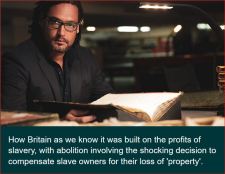 [Image, David Olusoga, “Britain’s Forgotten Slave Owners,” BBC]
[Image, David Olusoga, “Britain’s Forgotten Slave Owners,” BBC]
“A new BBC documentary [2015] tells how a trove of documents lays bare the names of Britain’s 46,000 slave owners, including relatives of Gladstone and Orwell.”…
“Whereas the cotton plantations of the American south were established on the soil of the continental United States, British slavery took place 3,000 miles away in the Caribbean.
That geographic distance made it possible for slavery to be largely airbrushed out of British history, following the Slavery Abolition Act in 1833. Many of us today have a more vivid image of American slavery than we have of life as it was for British-owned slaves on the plantations of the Caribbean.
The word slavery is more likely to conjure up images of Alabama cotton fields and whitewashed plantation houses, of Roots, Gone With The Wind and 12 Years A Slave,
than images of Jamaica or Barbados in the 18th century.
The history of British slavery has been buried. The thousands of British families who grew rich on the slave trade, or from the sale of slave-produced sugar, in the 17th and 18th centuries, brushed those uncomfortable chapters of their dynastic stories under the carpet. Today, across the country,
heritage plaques on Georgian townhouses
describe former slave traders as “West India merchants”,
while slave owners are hidden behind the
equally euphemistic term
Thousands of biographies written in celebration of notable 17th and 18th-century Britons have reduced their ownership of human beings to the footnotes, or else expunged such unpleasant details altogether. The Dictionary of National Biography has been especially culpable in this respect. Few acts of collective forgetting have been as thorough and as successful as the erasing of slavery from the Britain’s “island story.” If it was geography that made this great forgetting possible,what completed the disappearing act was our collective fixation with the one redemptive chapter in the whole story. William Wilberforce and the abolitionist crusade, first against the slave trade and then slavery itself, has become a figleaf behind which the larger, longer and darker history of slavery has been concealed.
It is still the case that Wilberforce remains the only household name of a history that begins during the reign of Elizabeth I and ends in the 1830s.
There is no slave trader or slave owner and certainly no enslaved person who can compete with Wilberforce when it comes to name recognition.
Little surprise then that when, in 2007, we marked the bicentenary of the abolition of the transatlantic slave trade, the only feature film to emerge from the commemoration was Amazing Grace, a Wilberforce biopic.
George Orwell once likened Britain to a wealthy family that maintains a guilty silence about the sources of its wealth. Orwell, whose real name was Eric Blair, had seen that conspiracy of silence at close quarters. His father, Richard W Blair, was a civil servant who oversaw the production of opium on plantations near the Indian-Nepalese border and supervised the export of that lethal crop to China. The department for which the elder Blair worked was called, unashamedly, the opium department. However, the Blair family fortune-which had been largely squandered by the time Eric was born-stemmed from their investments in plantations far from India.
(“A print shows African captives being taken on board a slave ship. Photograph: Print Collector/Getty”)
The Blair name is one of thousands that appear in a collection of documents held at the National Kew….The T71 files consist of 1,631 volumes of leather-bound ledgers and neatly tied bundles of letters that have lain in the archives for 180 years, for the most part unexamined. They are the records and the correspondence of the Slave Compensation Commission.
The Slavery Abolition Act of 1833 [actually 1888, see below] formally freed 800,000 Africans who were then the legal property of Britain’s slave owners. What is less well known is that the same act contained a provision for the financial compensation of the owners of those slaves,
by the British taxpayer, for the loss of their “property.”
The compensation commission was the government body established to evaluate the claims of the slave owners and administer the distribution of the £20m [$27.6M US] the government had set aside to pay them off. That sum represented 40% of the total government expenditure for 1834. It is the modern equivalent of between £16bn and £17bn [$23.4B US].
The compensation of Britain’s 46,000 slave owners was the largest bailout in British history until the bailout of the banks in 2009. Not only did the slaves receive nothing, under another clause of the act they were compelled to provide 45 hours of unpaid labour each week for their former masters, for a further four years after their supposed liberation. In effect, the enslaved paid part of the bill for their own manumission.
The records of the Slave Compensation Commission are an unintended byproduct of the scheme. They represent a near complete census of British slavery as it was on 1 August, 1834, the day the system ended [actually it ended in 1888]. For that one day we have a full list of Britain’s slave owners. All of them. The T71s tell us how many slaves each of them owned, where those slaves lived and toiled, and how much compensation the owners received for them.
Although the existence of the T71s was never a secret,
that a team from University College London began to systematically analyse them. The Legacies of British Slave-ownership project, which is still continuing, is led by Professor Catherine Hall and Dr Nick Draper, and the picture of slave ownership that has emerged from their work
is not what anyone was expecting.
The large slave owners, the men of the “West India interest”, who owned huge estates from which they drew vast fortunes, appear in the files of the commission. The man who received the most money from the state was John Gladstone, the father of Victorian prime minister William Ewart Gladstone. He was paid £106,769 [$147.8 US] in compensation for the 2,508 slaves he owned across nine plantations, the modern equivalent of about £80m [$110.5M US]. Given such an investment, it is perhaps not surprising that William Gladstone’s maiden speech in parliament was in defence of slavery.
The records show that for the 218 men and women he regarded as his property, Charles Blair, the great-grandfather of George Orwell, was paid the more modest sum of £4,442 – the modern equivalent of about £3m [$4.1M US]. There are other famous names hidden within the records. Ancestors of the novelist Graham Greene, the poet Elizabeth Barrett Browning, and the architect Sir George Gilbert Scott all received compensation for slaves.
As did a distant ancestor of David Cameron.
But what is most significant is the revelation of the smaller-scale slave owners. Slave ownership, it appears, was far more common than has previously been presumed. Many of these middle-class slave owners had just a few slaves, possessed no land in the Caribbean and rented their slaves out to landowners, in work gangs.These bit-players were home county vicars, iron manufacturers from the Midlands and lots and lots of widows. About 40% of the slave owners living in the colonies were women. Then, as now, women tended to outlive their husbands and simply inherited human property through their partner’s wills.
The geographic spread of the slave owners who were resident in Britain in 1834 was almost as unexpected as the gender breakdown. Slavery was once thought of as an activity largely limited to the ports from which the ships of the triangular trade set sail; Bristol, London, Liverpool and Glasgow. Yet there were slave owners across the country, from Cornwall to the Orkneys. In proportion to population, the highest rates of slave ownership are found in Scotland.
The T71 files have been converted into an online database; a free, publicly available resource….
There are, however, millions of people, in the Caribbean and the UK, who do not need a database to tell them that they are linked to Britain’s hidden slave-owning past. The descendants of the enslaved carry the same English surnames that appear in the ledgers of the Slave Compensation Commission – Gladstone, Beckford, Hibbert, Blair, etc – names that were imposed on their ancestors, initials that were sometimes branded on their skin, in order to mark them as items of property.”
Britain’s Forgotten Slave Owners, the first of two episodes, presented by David Olusoga, will be broadcast on Wednesday on BBC2. Click here for the Legacies of British Slave Ownership Database
………………………………………………………………
Added: “The [UK] Treasury’s tweet shows slavery is still misunderstood,” UK Guardian, David Olusoga, 2/12/2018, UK Guardian…[Further, by 1834 it was far from a great achievement. Slave trade to Jamaica had been abolished in 1809. The “market value” for British Caribbean “property” was rapidly dwindling. Nor could they sell their “property” to the US].
[Above: Her Majesty’s Treasury Tweet, 2/9/2018]
“The modern equivalent of £17bn [$23.4 billion US] was paid out to compensate [UK] slave owners for the loss of their human property. Some people believe we should be proud.”
“It is hard to imagine why somebody at the Treasury thought that the subject of slavery was fertile territory from which they might harvest their weekly “surprising #FridayFact”. Just after lunchtime on 9 February [2018] the department’s Twitter page presented its third of a million followers with its latest offering.
“Millions of you helped end the slave trade through your taxes,”
it trumpeted.
Below, under an image of Africans being marched, in yokes and ropes, into slavery, the tweet continued:
“Did you know? In 1833, Britain used £20 million, 40% of its national budget, to buy freedom for all slaves in the Empire. The amount of money borrowed for the Slavery Abolition Act was so large that
it wasn’t paid off until 2015.
Which means that living British citizens helped pay to end the slave trade.”
The “fact” had the unctuous feel of a pat on the back….What the Treasury didn’t mention, though, was that the £20m
was paid out to the 46,000 slave owners,
to compensate them for the loss of their human property. By one calculation that is the modern equivalent of about £17bn [$23.4 US]. Is this really something we should regard with collective pride?
Few people in the 1830s would have seen it that way. Compensation was a mechanism by which Britain was finally able to end a system that millions of people had come to regard as abhorrent, and a national disgrace. It was a way out….The only people who saw the payment of compensation as a positive were the people who had spent three decades campaigning for it and would be the beneficiaries of it–the slave owners.
And the slave owners not only received compensation from the British taxpayer, they won another concession, the euphemistically titled “apprenticeship” system. What this meant was that the slaves themselves were forced to work the fields for a further six years [to 1840] after the supposed abolition of slavery–45 hours a week
for no pay….
To pay the £20m to the slave owners, the government set up the Slave Compensation Commission, which…left behind detailed records of its financial outgoings. By accident, the process of compensation created a nearly complete census of British slavery: the names of all the slave owners on 1 August 1834, the day on which slavery ended–and of course “apprenticeship” began. This is how we know the scale of slave ownership of the so-called plantocracy, the super-rich of their age: men such as John Gladstone, the father of prime minister William Ewart Gladstone.
The Gladstones were paid £100,000–the modern equivalent of about £80m [$110 million US]--in compensation for 2,500 men, women and children they regarded as property. Also in the records of the Slave Compensation Commission are the ancestors of George Orwell, Graham Greene, Elizabeth Barrett Browning, George Gilbert Scott
and David Cameron--all owned slaves and received compensation. All of this information is publicly and freely available on the website of the University College London’s Legacies of British Slave-Ownership project.
Although called a #FridayFact, what we are dealing with here is a factoid: a fact-like entity that crumbles on proper examination. It was not only wrongly judged, in numerous respects it was just wrong. Compensation was not paid at the end of “the slave trade.” That ended in 1807.
The slave trade and slavery–confusing as that may be to us – were regarded almost as separate issues at the time. Compensation was paid 30 years later, at the end of slavery.
To make matters worse, the picture chosen to illustrate the #FridayFact was (again) of the slave trade rather than slavery; and, judging by the dress of the slave traders depicted, it was a Victorian image of the eastern slave trade, through which Arab and African-Arab slave traders trafficked millions of Africans to lives of enslavement in the Middle East–a too often neglected aspect of the global story of slavery.
Even the most essential details were wrong. The 1833 [1834] act did not free “all slaves in the Empire,” as the most rudimentary research would have shown.
Someone at the Treasury wisely deleted the tweet within hours. Yet its inaccuracy shows what happens if we as a nation focus on abolition but stay largely silent on the centuries of slave-trading and slave-owning that predated it. It is what happens when those communities for whom this history can never be reduced to a Friday factoid remain poorly represented within our national institutions.”
………………………………………….
………………………………….
Added: “Jamaica’s Slave Trade 1655 to 1809″
“The table below shows the number of slaves that were transported directly from Africa to Jamaica from 1655 to 1809, when the transatlantic trade was abolished:”
Above map: “Breakdown of Embarkation Regions in Jamaica’s Slave Trade 1655 to 1809," “Source: Slave Voyages Database – Trans-Atlantic Slave Trade – Estimates,” via jamaicagreathouses.com
............
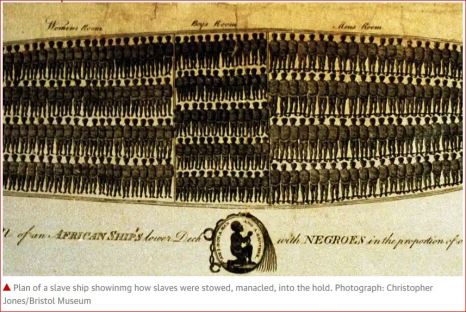
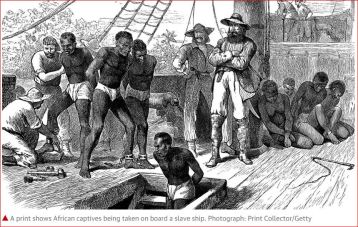
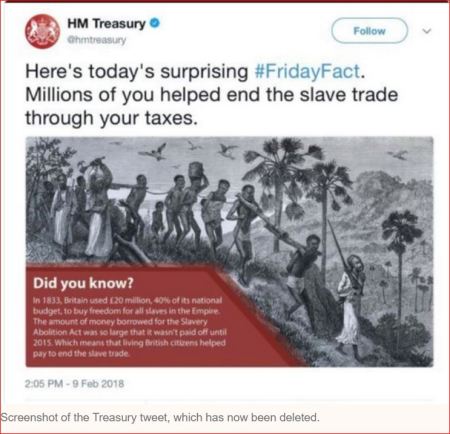
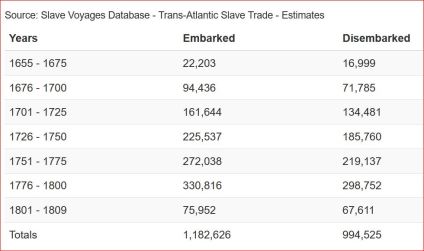
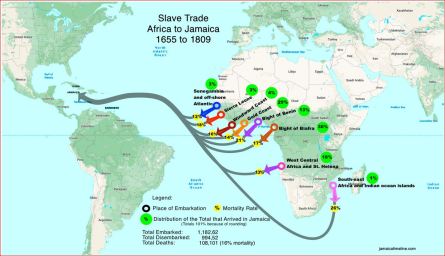
No comments:
Post a Comment